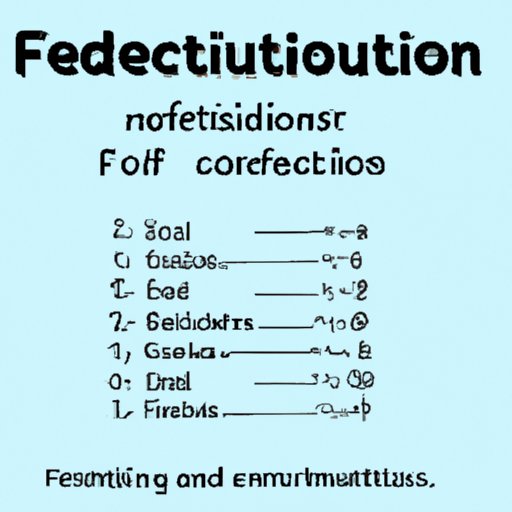Introduction
Welcome to this comprehensive guide on how to convert a fraction to decimal. This guide is for anyone who wants to learn how to convert fractions to decimals, whether you are a student, a teacher, or simply someone who wants to brush up on their math skills. In this guide, we will cover the step-by-step process for converting fractions to decimals, quick tips and tricks for more efficient conversion, why it’s important to know how to convert fractions to decimals, mistakes to avoid, and fun ways to practice this skill.
Step-by-Step Guide on Converting Fractions to Decimals
The process of converting fractions to decimals is straightforward and involves dividing the numerator by the denominator. Here is a step-by-step guide to converting any fraction to its equivalent decimal form:
- Write the fraction down.
- Divide the numerator by the denominator.
- Round the decimal to the desired number of places.
For example, let’s convert the fraction 3/4 to a decimal using this process:
- Write down 3/4.
- Divide 3 by 4. The answer is 0.75.
- Round to the desired number of places. In this example, let’s round to two decimal places. The final answer is 0.75.
Quick Tips for Converting Fractions to Decimals
While the above step-by-step guide is a foolproof way to convert any fraction to a decimal, there are some handy tips and tricks that you can use to quickly convert fractions to decimals. Here are some quick tips:
- Memorize common fractions like 1/2, 1/4, 1/5, 1/10, and 1/100. Knowing these fractions can make converting other fractions that are multiples of them quicker and easier.
- Use patterns to quickly recognize recurring decimals. For example, 1/3 is 0.3333… and 2/3 is 0.6666…
- Know your decimal equivalents of fractions. For example, 1/8 is 0.125, 1/6 is 0.1666…, and so on.
Why Knowing How to Convert Fractions to Decimals is Important
Knowing how to convert fractions to decimals is a fundamental math skill that has practical applications beyond the classroom. Here are some scenarios in which knowing how to convert fractions to decimals is useful:
- Working with money. When dealing with money, it is often necessary to convert fractions of dollars to decimal form.
- Calculating percentages. Percentages are often expressed as decimals, so knowing how to convert fractions to decimals is crucial for percentage calculations.
- Adjusting recipes. Many recipes call for fractions of ingredients, but having these measurements in decimal form can make it easier to modify recipes for different serving sizes.
Common Mistakes to Avoid When Converting Fractions to Decimals
Even though converting fractions to decimals is a straightforward process, there are some common mistakes to look out for. Here are some mistakes to avoid:
- Dividing the denominator by the numerator instead of the numerator by the denominator.
- Misplacing the decimal point. Double-check that the decimal point is in the correct place before rounding.
- Rounding incorrectly. Be sure to round to the desired number of decimal places and use appropriate rounding rules.
Fun Ways to Practice Converting Fractions to Decimals
Practicing converting fractions to decimals can be fun and engaging. Here are some ideas for making learning this skill more enjoyable:
- Play fraction/decimal conversion games online or on an app.
- Create a math scavenger hunt where players have to solve fraction to decimal problems to advance to the next clue.
- Use food items such as pizza or pie to demonstrate fraction to decimal conversion. Cut it into slices of varying sizes, and have players convert the number of slices to decimal form.
Conclusion
Converting fractions to decimals is an essential math skill that has real-life applications beyond the classroom. By following the step-by-step guide outlined in this article and utilizing the tips and tricks provided, converting a fraction to a decimal can be done quickly and efficiently. Remember to double-check for common mistakes such as misplaced decimal points or incorrect rounding. Lastly, make practicing this skill fun and engaging by incorporating games or interactive activities.
